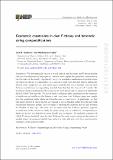| dc.contributor.author | Anderson, Lara B. | |
| dc.contributor.author | Taylor, Washington | |
| dc.date.accessioned | 2014-11-03T14:48:25Z | |
| dc.date.available | 2014-11-03T14:48:25Z | |
| dc.date.issued | 2014-08 | |
| dc.date.submitted | 2014-05 | |
| dc.identifier.issn | 1029-8479 | |
| dc.identifier.issn | 1126-6708 | |
| dc.identifier.uri | http://hdl.handle.net/1721.1/91263 | |
| dc.description.abstract | We systematically analyze a broad class of dual heterotic and F-theory models that give four-dimensional supergravity theories, and compare the geometric constraints on the two sides of the duality. Specifically, we give a complete classification of models where the heterotic theory is compactified on a smooth Calabi-Yau threefold that is elliptically fibered with a single section and carries smooth irreducible vector bundles, and the dual F-theory model has a corresponding threefold base that has the form of a ℙ[superscript 1] bundle. We formulate simple conditions for the geometry on the F-theory side to support an elliptically fibered Calabi-Yau fourfold. We match these conditions with conditions for the existence of stable vector bundles on the heterotic side, and show that F-theory gives new insight into the conditions under which such bundles can be constructed. In particular, we find that many allowed F-theory models correspond to vector bundles on the heterotic side with exceptional structure groups, and determine a topological condition that is only satisfied for bundles of this type. We show that in many cases the F-theory geometry imposes a constraint on the extent to which the gauge group can be enhanced, corresponding to limits on the way in which the heterotic bundle can decompose. We explicitly construct all (4962) F-theory threefold bases for dual F-theory/heterotic constructions in the subset of models where the common twofold base surface is toric, and give both toric and non-toric examples of the general results. | en_US |
| dc.description.sponsorship | United States. Dept. of Energy (Contract DE-FC02-94ER40818) | en_US |
| dc.description.sponsorship | National Science Foundation (U.S.) (Grant PHY-1066293) | en_US |
| dc.language.iso | en_US | |
| dc.publisher | Springer-Verlag | en_US |
| dc.relation.isversionof | http://dx.doi.org/10.1007/JHEP08(2014)025 | en_US |
| dc.rights | Creative Commons Attribution | en_US |
| dc.rights.uri | http://creativecommons.org/licenses/by/4.0/ | en_US |
| dc.source | Springer-Verlag | en_US |
| dc.title | Geometric constraints in dual F-theory and heterotic string compactifications | en_US |
| dc.type | Article | en_US |
| dc.identifier.citation | Anderson, Lara B., and Washington Taylor. “Geometric Constraints in Dual F-Theory and Heterotic String Compactifications.” J. High Energ. Phys. 2014, no. 8 (August 2014). | en_US |
| dc.contributor.department | Massachusetts Institute of Technology. Center for Theoretical Physics | en_US |
| dc.contributor.department | Massachusetts Institute of Technology. Department of Physics | en_US |
| dc.contributor.mitauthor | Taylor, Washington | en_US |
| dc.relation.journal | Journal of High Energy Physics | en_US |
| dc.eprint.version | Final published version | en_US |
| dc.type.uri | http://purl.org/eprint/type/JournalArticle | en_US |
| eprint.status | http://purl.org/eprint/status/PeerReviewed | en_US |
| dspace.orderedauthors | Anderson, Lara B.; Taylor, Washington | en_US |
| dc.identifier.orcid | https://orcid.org/0000-0001-8566-6706 | |
| mit.license | PUBLISHER_CC | en_US |
| mit.metadata.status | Complete | |
